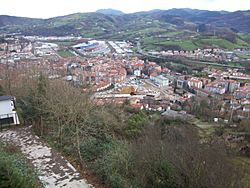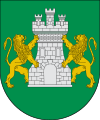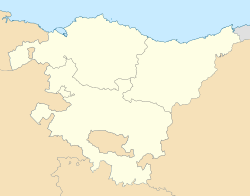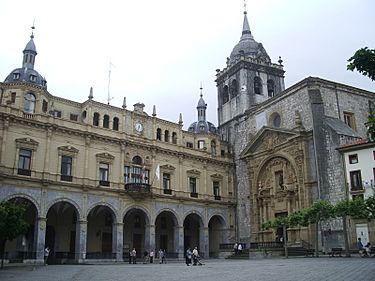Hernani, Spain facts for kids
Quick facts for kids
Hernani
|
||
|---|---|---|
|
Municipality
|
||

Hernani
|
||
|
||
| Country | Spain | |
| Autonomous Community | ||
| Province | ||
| Eskualdea | Donostialdea | |
| Area | ||
| • Total | 40 km2 (20 sq mi) | |
| Elevation
(AMSL)
|
44 m (144 ft) | |
| Time zone | UTC+1 (CET) | |
| • Summer (DST) | UTC+2 (CEST (GMT +2)) | |
| Postal code |
20120
|
|
| Area code(s) | +34 (Spain) + 943 (Gipuzkoa) | |
| Website | www.hernani.eus | |
Hernani is a town and municipality in the Basque Country, Spain. It's located in the province of Gipuzkoa. The town sits on the left side of the Urumea river. It is about 9.2 kilometers (5.7 miles) from San Sebastián.
The area of Hernani is about 40 square kilometers (15 square miles). It shares borders with San Sebastián, Astigarraga, Arano, Elduayen, Errenteria, Lasarte-Oria, and Urnieta. From the town center, you can see a large part of the Urumea valley.
Hernani celebrates its main festivals from June 23 to 27. These honor John the Baptist. A special dance called "azeri dantza" is a highlight of these celebrations. The famous play Hernani by Victor Hugo is named after this town.
Contents
History of Hernani

Early History of the Valley
During the Middle Ages, the region that became the province of Gipuzkoa was divided into valleys. Hernani was one of these valleys. The valley of Hernani once covered a large area around the lower parts of the Urumea and Oria rivers.
Old documents mention the valley of Hernani. One document from the year 938 talks about a grant by a Castilian count. Another document from the late 1100s mentions the Monastery of San Sebastián being "in the borders of Hernani."
How Hernani Became a Town
When King Sancho VI of Navarre founded the town of San Sebastián around 1180, the Hernani valley became part of its area. We don't know exactly when Hernani became a town. Its original town charter was lost in a fire.
Some historians think Hernani became a town in the late 1200s. This was when King Alfonso X of Castile created a network of important towns along the coast of Gipuzkoa. Others believe it happened later, around 1379. A document from the 1400s mentions an agreement between Hernani and San Sebastián from 1379, showing Hernani was a town by then.
The Old Town of Hernani
The town of Hernani did not cover the entire old valley. It lost the coastal areas to San Sebastián. It also lost the western area near the Oria river, which became the town of Usurbil in 1371. The old town of Hernani is on a small hill, 42 meters (138 feet) high. It overlooks the Urumea river and is at the foot of Mount Santa Barbara.
The old town was shaped like an oval and had walls around it. There were several entrances, but only one remains today. The town originally had two main streets, Kale Nagusia (High Street) and Kardaberaz Street. These were crossed by a smaller lane.
Challenges and Changes Over Time
The first local laws for Hernani were written in 1542. Earlier copies from 1512 were lost during a French army invasion. Hernani has faced many invasions and destruction throughout its history. These include medieval wars, French invasions in the 1600s, 1700s, and 1800s. It also saw tough battles during the Carlist Wars and the Spanish Civil War in 1936.
In 1986, a historical part of Hernani called Lasarte became its own town, Lasarte-Oria. This happened because Lasarte grew very quickly.
Culture and Traditions
Language Spoken in Hernani
Hernani is in an area where Basque is traditionally spoken. The town has a mix of Basque and Spanish speakers. Many people in Hernani can speak both languages.
Fun Things to Do
Hernani is famous for its Basque cider production. It's one of the most important towns for making this traditional drink. Many cider houses, called sagardotegiak, are found here.
During cider season, which usually runs from January to May, many visitors come to Hernani. They visit the cider houses to enjoy the fresh cider. The bars in the old town are especially lively on weekends during this time.
Celebrations and Festivals
The town's main festivals are at the end of June. They celebrate St. John the Baptist on June 24. On June 24, 25, and 26, a special dance called the Maskuri-danza or Azeri-danza is performed. It's also known as the "dance of the fox." A character with a fox mask was added to the dance in the 1980s.
Different neighborhoods in Hernani also have their own festivals. For example, Elizatxo celebrates Santa Cruz, and Ereñozu celebrates San Antonio.
Important Buildings and Monuments
The old town of Hernani is considered a "Monumental Ensemble." This means it has many important historical buildings and a preserved medieval street layout.
- Religious Sites:
- Parochial Church of San Juan Bautista (St. John the Baptist Church)
- Convent of San Agustin
- Igoin-Akola Dolmen (an ancient stone structure)
- Cromlechs (ancient stone circles)
- Civil Buildings:
- Town Hall
- Fort of Santa Barbara
- Tower-house of the Gentiles (or Portalondo)
- Laundry and public fountain of Leoka
- Gateway to the village in Zapa street (part of the old town walls)
Museums to Visit
The Chillida Leku museum in Hernani is dedicated to the works of sculptor Eduardo Chillida. He was born in nearby San Sebastián. It's a great place to see amazing art.
Population Changes
How Hernani's Population Grew
Starting in the 1960s, Hernani's population grew a lot. This was mainly because many workers moved there from other parts of Spain. They came for jobs in the growing industries. This growth slowed down in the late 1970s and early 1980s due to economic and political changes.
In 1986, the district of Lasarte separated from Hernani. It became part of a new town called Lasarte-Oria. This meant Hernani lost about 10,000 residents. In the last 20 years, Hernani's population has stayed fairly steady.

Economy and Jobs
How People Work in Hernani
Hernani has many jobs, with about 8,722 jobs in 2010. This is about 45% of the total population. The industry sector provides about 45% of these jobs. There are 240 industrial businesses in the town.
Most people in Hernani work in the service sector (62%). This includes jobs in shops, restaurants, and other services. Industry employs 26% of the people, and construction employs 10%. Only a small number (1%) work in farming.
Local Businesses and Industries
Hernani is a very industrial town. It has about 240 industrial companies located along the Urumea river. These areas are called polygons, like Landare and Zikuñaga. Hernani's industries make many different products.
One major company is Orona, which makes and installs elevators. It has over 800 employees. Another important company is Papelera Guipuzcoana de Zicuñaga, which makes paper. Hernani also has many chemical companies.
Some of the larger companies in Hernani with more than 50 workers include:
- Arkema Chemistry: Makes PVC (a type of plastic).
- Tapes Ubis: Makes different kinds of tapes.
- Goiplastik: Makes plastic parts using injection molding. This company is part of the Gureak Group, which employs people with disabilities.
- Jesus Romero and Sons: Works with DC motors and electronic equipment. They also repair electrical machines.
- Krosaki AMR Refractories: Produces materials that can withstand very high temperatures.
- Loire SAFE: Makes machine tools.
- Oiarso (Bexen): Produces medical equipment for single use. It's a cooperative from the Mondragon Corporation.
- Orona: Makes elevators, ramps, and escalators. Also a Mondragon Cooperative.
- Papelera Guipuzcoana de Zicuñaga (Iberpapel Group): A paper manufacturing company.
- Special Profiles Selak (Savera Group): Shapes metal profiles by rolling.
- Society of Packages, Tubes and Cases (SETE): Makes aluminum containers and tubes.
A long time ago, the steel company Pedro Orbegozo was very important. It employed almost 1,500 people from Hernani. The company closed in 1992 after a long crisis. This had a big effect on the local economy. The area where this company once stood is now called Ibaiondo Polygon.
Food and Drink
Local Specialties
A special dish in Hernani is wild boar cooked with cider. It's a unique local flavor!
During cider season, the sagardotegiak (cider houses) offer a traditional meal. This usually includes cod fish omelette or cod fish with peppers, and a steak. For dessert, you can enjoy Idiazabal cheese, quince jelly, and walnuts. Hernani is home to about one hundred cider houses.
Media and News
- Hernaniko kronika: This is the only daily newspaper published in the Basque language.
- Molotoff Irratia: A local free radio station.
Neighborhoods of Hernani
|
|
|
|
Sports in Hernani
Football Team
Club Deportivo Hernani is the town's football (soccer) team. It was started in 1940. In 1955, the team reached the Spanish Third Division. Its highest achievement was playing in the Second Division B in 1991.
Rugby Team
Hernani Club de Rugby Elkartea (HCRE) is a very respected rugby team. They play in the Spanish Division of Honour, which is a top league. Their best result was finishing second in the 1983/84 season. This team is known for training many local players who then play in the top division.
Famous People from Hernani
- Juan de Urbieta (?–1553): An infantry soldier famous for capturing Francis I of France during the Battle of Pavia in 1525.
- Agustín de Cardaberaz (1703–1770): A Catholic priest, preacher, and writer who wrote in the Basque language.
- Florentino Goikoetxea: A Basque smuggler who helped Allied airmen escape from occupied Europe to neutral Spain during World War II.
- José Manuel Lujambio, Txirrita (1860-1936): A bertsolari, which is a singer who improvises musical verses in Basque. He was the champion of the Basque Country in 1936.
- Maialen Lujanbio (1976– ): Also a bertsolari. She was the champion of the Basque Country in 2009 and 2017.
- Gabriel Celaya (1911–1991): A well-known poet from the post-war generation.
- Elías Querejeta (1934–2013): A filmmaker who worked as a producer, director, and scriptwriter.
- Martín Zabaleta (1949): A mountain climber. He was the first Basque person to climb Mount Everest.
- Pedro Ochotorena (1954): A professional football goalkeeper.
- Ion Insausti (1984): An international rugby player.
See also
 In Spanish: Hernani para niños
In Spanish: Hernani para niños






